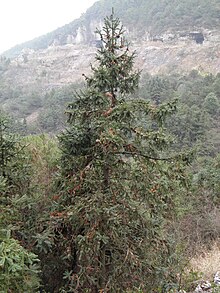Cunninghamia
| Cunninghamia Temporal range:
| |
|---|---|

| |
| Cunninghamia lanceolata | |
| Scientific classification | |
| Kingdom: | Plantae |
| Clade: | Tracheophytes |
| Clade: | Gymnospermae |
| Division: | Pinophyta |
| Class: | Pinopsida |
| Order: | Cupressales
|
| Family: | Cupressaceae |
| Subfamily: | Cunninghamioideae (Zucc. ex Endl.) Quinn |
| Genus: | Cunninghamia R.Br. ex Richard & Richard |
| Type species | |
Cunninghamia sinensis
ex Richard & Richard | |
| Species | |
| |
| Synonyms[1] | |
| |
Cunninghamia is a genus of one



Description
The general shape of the tree is conical with tiered, horizontal
The cones are small and inconspicuous at pollination in late winter, the pollen cones in clusters of 10–30 together, the female cones singly or 2–3 together.
The seed cones mature in 7–8 months to 2.5–4.5 cm long, ovoid to globose, with spirally arranged scales; each scale bears 3–5 seeds. They are often proliferous (with a vegetative shoot growing on beyond the tip of the cone) on cultivated trees; this is rare in wild trees, and may be a cultivar selected for easy vegetative propagation for use in forestry plantations.
As the tree grows its trunk tends to sucker around the base, particularly following damage to the stem or roots, and it then may grow in a multi-trunked form. Brown bark of mature trees peels off in strips to reveal reddish-brown inner bark. Older specimens often look ragged, as the old needles may cling to stems for up to 5 years.
Although it resembles conifer species found in much colder climates, the tree is highly tolerant of heat, and can be found growing down to sea level in regions such as Hong Kong.
Taxonomy
It is the most basal extant member of the Cupressaceae. Phylogenetic evidence indicates that its lineage diverged from the rest of the family during the early Jurassic.[5] Fossil representatives of the subfamily Cunninghamioideae, of which Cunninghamia is the only living member, extend back to the Middle Jurassic. The subfamily, which has 12 described genera, experienced a high diversity during the Cretaceous, but underwent a severe decline at the end of the Cretaceous, leaving Cunninghamia as the only living genus by the beginning of the Cenozoic.[6]
In the past, the genus was usually treated in the family Taxodiaceae,[2] but this family is now included within the Cupressaceae.[3] A few botanists have also treated it in a family of its own, Cunninghamiaceae, but this is not widely followed.[7] The oldest fossil species of the genus are from the Late Cretaceous (Campanian) of North America, including Cunninghamia hornbyensis from British Columbia, Canada,[8] and Cunninghamia taylorii from the Horseshoe Canyon Formation of Alberta, Canada.[9] Other fossils are known from the Cenozoic of Asia, North America and Europe.[6][10]
The genus is traditionally said to contain two similar species, Cunninghamia lanceolata and C. konishii, often referred to as the China fir and Taiwan fir, respectively. C. lanceolata occurs in mainland China, Vietnam, and Laos, whereas C. konishii is restricted to Taiwan.[11] However, molecular genetic evidence is suggesting that they are the same species, and that C. konishii of Taiwan derive from multiple colonizations from the mainland.[12][13] As C. lanceolata was the first name published, this name takes priority if the two are combined. In that case, Taiwan fir becomes Cunninghamia lanceolata var. konishii. However, there is no consensus yet as to whether the two species should be combined.[11]
Usage
Cunninghamia is a prized
Cunninghamia is grown as an ornamental tree in
References
- ^ Kew World Checklist of Selected Plant Families
- ^ a b c d Fu, Liguo; Yu, Yong-fu; Adams, Robert P.; Farjon, Aljos. "Cunninghamia". Flora of China. Vol. 4. Retrieved 9 September 2012 – via eFloras.org, Missouri Botanical Garden, St. Louis, MO & Harvard University Herbaria, Cambridge, MA.
- ^ a b "Cunninghamia". Integrated Taxonomic Information System.
- ^ Brown, Robert (1866). "On the structure of the female flower in Cycadae and Coniferae". The Miscellaneous Botanical Works of Robert Brown. Vol. 1. p. 461.
- S2CID 236141481.
- ^ S2CID 237705866.
- ISBN 978-0-87071-573-0
- .
- S2CID 83890547.
- S2CID 134577533.
- ^ a b Earle, Christopher J., ed. (2018). "Cunninghamia". The Gymnosperm Database. Retrieved 9 September 2012.
- ^ Lu, S.Y.; T.Y. Chiang; K.H. Hong; T.W. Hu (1999). "Re-examination of the taxonomic status of Cunninghamia konishii and C. lanceolata based on the RFLPs of a chloroplast trnD-trnT spacer". Taiwan Journal of Forest Science. 14: 13–19. Archived from the original on 2014-07-14.
- PMID 15522804.
